Your Shopify Payments Account Is On Hold: Reasons And Solutions
Summer Nguyen | 02-06-2024
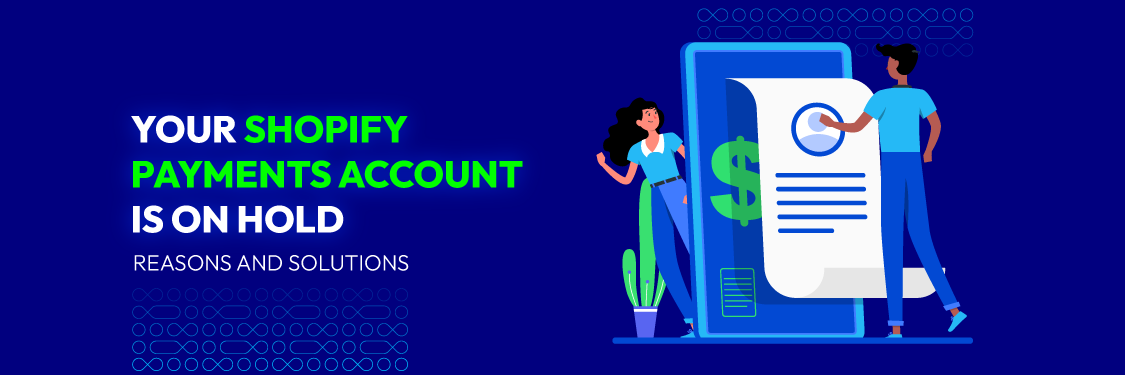
Shopify Payments is the go-to payment gateway for many Shopify merchants, offering seamless transactions and lower fees than alternatives like PayPal or Stripe. For high-sales stores, it’s especially appealing, helping to maximize profit margins. However, even the most merchant-friendly platform can hit a snag, and nothing disrupts a business faster than having your Shopify Payments account unexpectedly put on hold.
When your account is frozen, sales stop flowing, and panic sets in. But don’t worry—this issue is fixable. In this article, we’ll explore the common reasons why your Shopify payments account is on hold, and more importantly, provide clear steps to help you resolve the issue and get your revenue stream back on track.
Why Is Your Shopify Payments Account On Hold?
Shopify Payments accounts can be paused for various reasons, often related to risk management and compliance with Shopify’s financial policies and regulations. Merchants need to understand why this problem occurs so they can maintain business operations, protect revenue streams, and ensure customer trust.
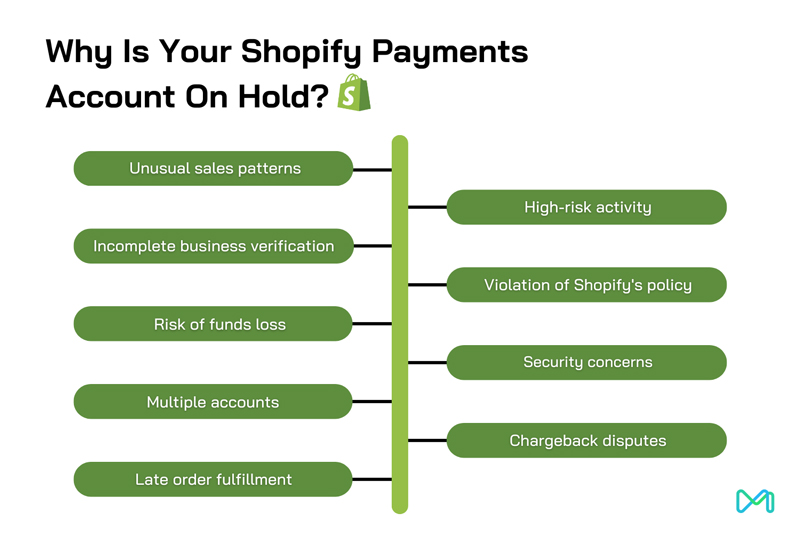
Some common reasons why your Shopify Payments account is on hold include:
Unusual Sales Patterns
If Shopify detects unusual or infrequent sales patterns, such as sudden spikes in sales or sales from high-risk regions, your account could be flagged. This is often a precautionary measure to prevent fraudulent transactions.
Example: A sharp increase in orders from international buyers without previous history can trigger a hold as Shopify investigates the legitimacy of the transactions.
High-Risk Activity
Accounts involved in high-risk activity are more likely to be put on hold. This includes frequent chargebacks, disputes, or potential fraud. High-risk activities may also include selling products that violate Shopify’s Acceptable Use Policy, such as firearms, adult content, or tobacco.
Example: If your store receives an abnormal number of chargebacks or if customers frequently dispute transactions, Shopify may suspend your payments until the issue is resolved.
Incomplete Business Verification
If you haven’t completed the necessary business verification processes such as providing accurate tax information, legal business name, or identification documents, Shopify may suspend your account until you fulfill these requirements.
Example: A new store that hasn’t uploaded the required legal documents for verification may face payment holds until all information is updated and accurate.
Violation Of Shopify’s Policy
Shopify has strict guidelines on the types of products and services allowed on its platform. Selling items from Shopify’s prohibited product list can lead to your Shopify Payments account being placed on hold or even terminated.
Example: A merchant starting to sell a newly restricted product without realizing it can face account suspension until they remove the item from their store.
Risk Of Funds Loss
In some cases, Shopify may detect a risk of financial loss related to your store. This can include unresolved disputes, excessive refunds, or a large volume of transactions in a short period that looks suspicious. Shopify may hold funds to protect both you and your customers.
Example: If there are multiple unresolved chargebacks that could lead to financial losses, Shopify may freeze payments to safeguard the merchant.
Security Concerns
If Shopify detects security threats such as hacking attempts or unauthorized access to your Shopify Payments account, it may freeze your account to prevent further damage. This is often done to protect sensitive customer and business data.
Example: A breach of your account’s security that results in unauthorized transactions may lead Shopify to temporarily hold payments to investigate the issue.
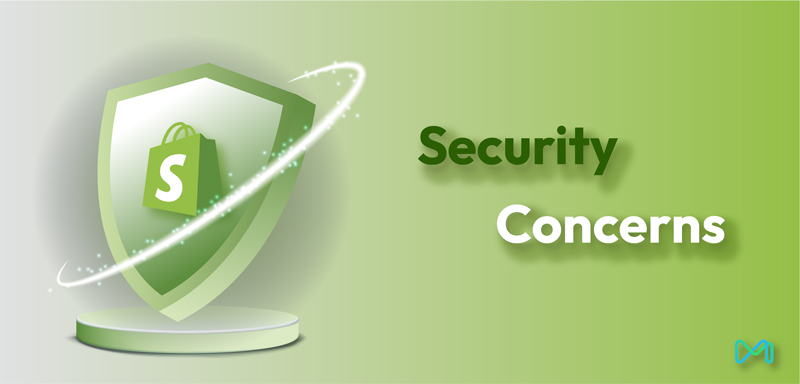
Multiple Accounts
If Shopify detects security threats such as hacking attempts or unauthorized access to your Shopify Payments account, it may freeze your account to prevent further damage. This is often done to protect sensitive customer and business data.
Shopify typically allows only one Shopify Payments account per business. If you’re operating multiple accounts for the same business or under different identities, Shopify may suspend your payment.
Chargeback Disputes
A high number of unresolved chargebacks can cause Shopify to place a hold on your account. It’s essential to actively manage and resolve disputes to avoid this issue.
Example: A store experiencing frequent disputes due to poor product descriptions or delayed shipments may face payment holds as Shopify assesses the risk of continuing chargebacks.
Late Order Fulfillment
Shopify may freeze the Shopify Payments accounts of merchants who repeatedly fail to deliver products to customers on time. That can happen if the seller has poor inventory management, unreliable shipping partners, or a high volume of complaints from customers.
Example: A store with consistent negative reviews about shipping times and order fulfillment may have its account put on hold until the issue is resolved.
How To Avoid Payment Account Hold From Shopify?
Having your Shopify Payment account suspended can seriously impact your business.
To avoid having your payment account placed on hold by Shopify, it’s important to follow Shopify’s policies and maintain a secure and trustworthy online store. Here are steps you can take to prevent a payment account hold.
Check Your Account Regularly
Keeping a close eye on your Shopify account helps you spot issues early and avoid disruptions. Regular account reviews allow you to identify potential problems and take action before they escalate.
- Stay alert for notifications: Check your Shopify admin dashboard frequently for updates or warnings related to your account status. Ignoring these can lead to delays in resolving issues.
- Track payment activity: Review your payouts and transaction history to ensure everything is running smoothly. Any delays or unusual patterns might indicate a problem.
- Stay informed on policy updates: Shopify’s guidelines can change, especially regarding restricted products. Regularly reviewing policies ensures compliance and prevents accidental violations.
By staying proactive, you can avoid surprises and maintain a seamless payment experience without unnecessary interruptions.
Verify Your Store Information
For Shopify, any discrepancy in your information can raise a red flag. So, first of all, ensure that the information you provide, including physical address, phone number, and email address, is completely accurate.
Additionally, Shopify will require you to provide documents verifying your store’s identity, including your business license, tax identification number, and bank statements. Please provide promptly to verify the legitimacy of your store.
Use Legitimate Payment Processing
Next, ensure your Shopify store uses a reputable and legitimate payment processor. Using the payment gateways Shopify recommends is the best way to avoid legal and financial troubles during purchasing. Payment providers at Shopify include Shopify Payments (highly recommended), Paypal, Stripe, etc.
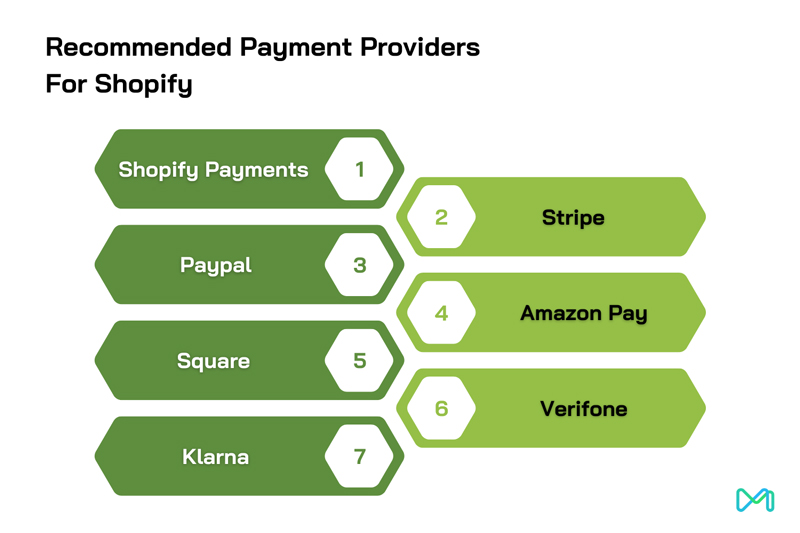
To choose the most suitable option for your store, consider exploring a comprehensive guide to the best payment providers for Shopify.
Additionally, keeping your payment gateway version up-to-date has a major impact on maintaining the security and reliability of your payment processing system.
Provide Clear Product Descriptions
Your Shopify store will look more reputable if you create high-quality product listings with accurate and detailed descriptions. Shopify Payments’ policies are not suitable for merchants with fraudulent trading intentions. So, conduct your business with transparency and integrity. You need to ensure that your product listing does not contain misleading information or false claims.
Keep your store content up to date, including product listings, prices, and availability. Outdated or inaccurate information that leads to customer dissatisfaction can also cause your Shopify Payments account to be suspended.
Prevent Excessive Chargebacks
In the course of your business, one main culprit for getting your Shopify Payments account suspended is chargebacks. Therefore, you need to take measures to prevent excessive chargebacks, such as clearly stating your refund and returns policy.
Provide excellent customer service to clearly communicate with customers about shipping times, delivery expectations, and product availability. Transparency will help you reduce the possibility of disputes.
Use Anti-Cheat Tools
Maintain strong security measures for your Shopify store to prevent unauthorized access and potential fraud. Besides using secure passwords and enabling two-factor authentication, you can seek the help of anti-fraud technologies, such as AVS (Address Verification Service) or CVV (Card Verification Value).
Additionally, you need to regularly check your store’s transactions and watch for any unusual or suspicious customer activity. These solutions can help you prevent fraudulent transactions and avoid legal problems. This ensures your payment gateway is always working properly and prevents your Shopify Payments account from being suspended.
Comply With Shopify Policies
Last but not least, you need to be familiar with and strictly comply with Shopify Payments’ terms of service. Ensure that your business operations and products comply with all laws and policy regulations.
Stay up to date on changes to Shopify policies, industry best practices, and emerging security threats. Continuous learning and adaptation are important to avoid having your Shopify Payments account put on hold.
Monitor Transactions
Monitoring your transactions regularly is vital to keeping your Shopify Payments account secure and in good standing.
Here’s how to stay on top of your transaction activity:
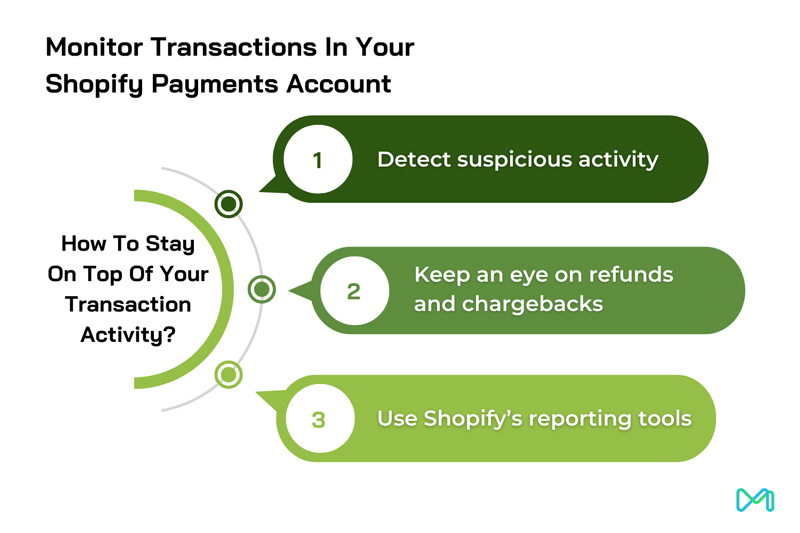
- Detect suspicious activity:
- Look for unexpected sales spikes.
- Watch for payments from unusual regions.
- Identify any unusual transaction values.
- Keep an eye on refunds and chargebacks:
- Address customer issues promptly to avoid chargebacks.
- Track recurring refund patterns that could signal a problem.
- Use Shopify’s reporting tools:
- Review transaction history with Shopify’s analytics.
- Spot trends and anomalies quickly through detailed reports.
By implementing these practices, you can ensure your transactions are smooth, secure, and free from disruptions.
Learn more: Shopify Payments Review: What’s New and Improved?
How To Reactivate A Suspended Shopify Payments Account?
If your Shopify Payments account is on hold, you’ll need to work with Shopify’s support team to resolve the issue and request reactivation. The specific requirements for reactivating a suspended Shopify Payments account may vary, depending on the reason for your violation. An outline of the procedures to reactivate a Shopify Payments account that has been suspended is provided below.
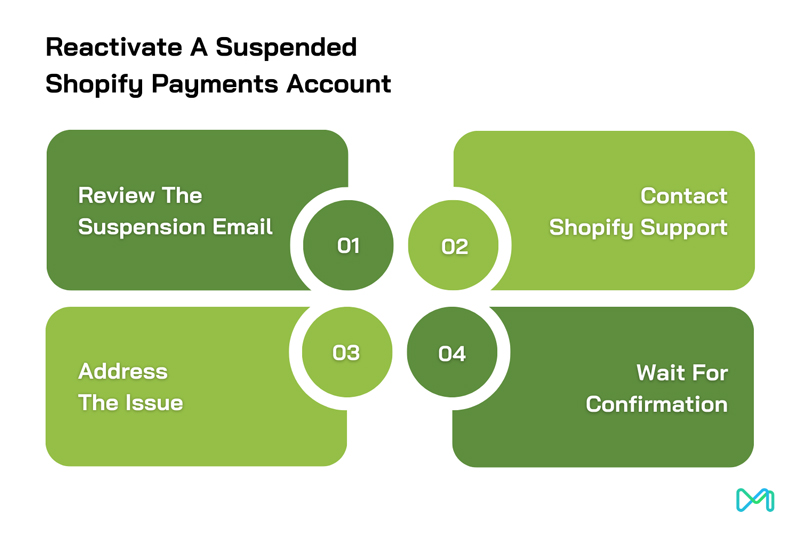
Review The Suspension Email
First, you must carefully review any email or notification from Shopify about suspending your Shopify Payments account. This is meant to clarify why your payment account was suspended and what you need to do to reactivate it. Please carefully review the following information:
- Reason for payment account suspension
- Adjustment time
- Corrective action
- Communications
You can complain to Shopify if you think your Shopify Payments account was suspended unfairly or after you’ve taken appropriate measures. Care must be taken during the appeals process, and any required papers or proof must be presented clearly and understandably.
Contact Shopify Support
Once you have captured the necessary information, contact Shopify support through the Shopify admin panel for timely resolution. Here, the support staff will answer your questions and provide appropriate troubleshooting methods for you to follow.
Address The Issue
Depending on the reason for the pause, you’ll need to take appropriate actions to resolve it. For example:
- If the pause is due to high-risk activity or a chargeback, take measures to reduce chargebacks and improve the security of your store.
- If it’s a compliance issue, ensure your business and product listings comply with Shopify’s policies.
- For identity verification requests, provide requested documents quickly and accurately.
As a result, you must get ready for whatever paperwork or data Shopify needs to fix the problem. Examples are business licenses, tax IDs, bank statements, and other proof documents. Throughout the resolution process, keep in touch with Shopify’s support staff frequently to offer any additional information that may be required.
Wait For Confirmation
It can take some time for Shopify to respond, depending on the intricacy of the situation and the reason your account was suspended. However, if the response takes longer than expected, you should contact Shopify Support to monitor the situation and deal with any problems as soon as they appear.
After resolving the problem, Shopify might need to confirm your modifications or enhancements. Therefore, you must be ready to provide evidence that your store is now secure and compliant. If Shopify finds that the problem has been fixed and your store complies with its rules, it will swiftly reactivate your Shopify Payments account.
Conclusion
In general, having your Shopify Payments account on hold can negatively impact your Shopify business. This may result in your store losing credibility or in the permanent locking of your payment account.
To avoid this issue in the future, adhere strictly to Shopify’s standards and best practices for online businesses while also closely monitoring transactions, customer interactions, and other shop activities.
If your Shopify Payments account is on hold, it’s critical that you cooperate with Shopify’s support team and promptly supply any required information and documentation to hasten the resolution process. Hopefully, this article has given you useful guidance to help you deal with this unforeseen issue.







